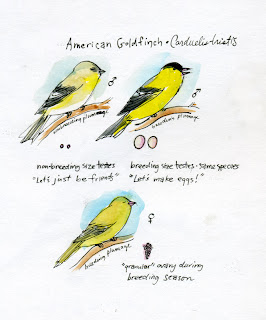Gonads and Strife

As I have mentioned before, I have become mostly independent in my specimen preparation. There is one area, however, that remains a mystery of mysteries: determining the gender. Many species of birds are not sexually dimorphic in their plumage or size, and so gender must be determined by the gonads. Even if the sex of the bird can be determined beyond a shadow of a doubt from the plumage, the size of the testes or ovary must be obtained and recorded. I am being slowly trained in the ways of determining bird gender. I say slowly because it is very easy for the inexperienced (me), in their efforts to locate the gonads, to end up removing them entirely, or scrambling things to the point beyond recognition (and fyi - an efficient way to irritate an experienced biologist). Unlike mammals and some reptiles, birds do not have external genitalia. They are located deep within the body cavity, near the liver. It is easier to train someone with birds obtained during the breeding season, as reproductive organs can increase dramatically in size during that time, thus making them easier to locate. Most females have one ovary, with some of the more common exceptions being raptors and kiwis. Dave Willard (who has 30 years experience behind him) has been training me, which means he'll locate the gonads first, determine the sex and then hand it over to me to see if I can figure it out. This has resulted, in more times than I care to admit, with me staring blankly through the magnifying visor and then pointing with the forceps at a lung, liver, or part of an intestine and saying "Eeeerm...female?!? Er...no I meant male?" After which, I am given a verbal pat on the hand, and I return to my seat and to the world I understand. Years ago someone sent me this *video. It's been playing in my head all week. Sigh. Gonads and strife, indeed. * Warning: I am not responsible if you are offended by gonads, dancing/singing squirrels, Ron Jeremy, or bad flash animation.

Comments
Post a Comment